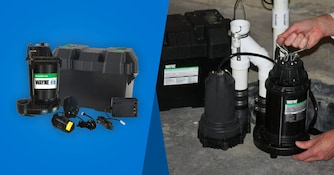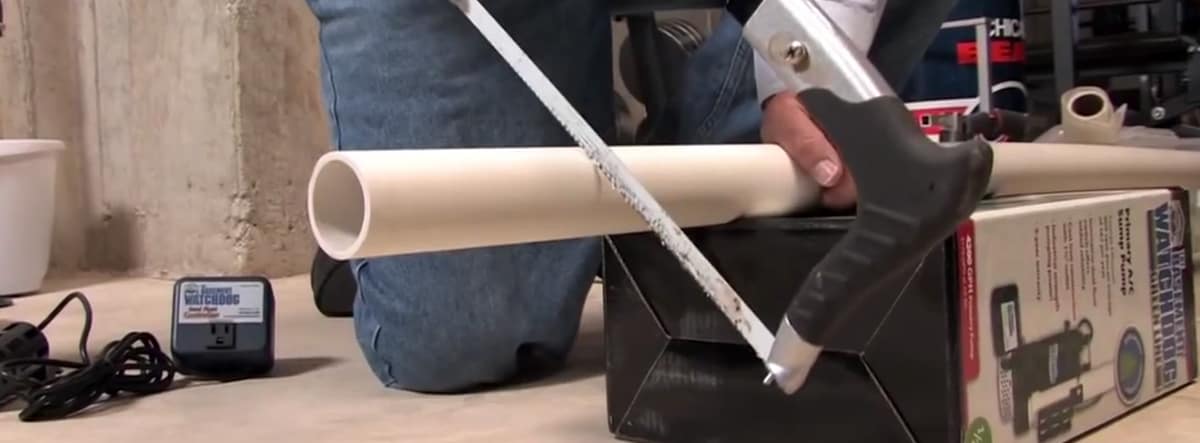
{"storeInfo":{"id":10,"name":"Sump Pumps Direct","domain":"sumppumpsdirect.com","initials":"SPD","url":"https:\/\/www.sumppumpsdirect.com","path":"\/var\/www\/vhosts\/spd.com\/"},"headerNavJSON":"{\"MainLinks\":[{\"URL\":\"\\\/pumps\\\/primary-sump-pumps.html\",\"displayText\":\"Primary Sump Pumps\",\"sectionLinks\":{\"columns\":\"6\",\"linkItems\":[{\"URL\":\"\\\/pumps\\\/primary-submersible-sump-pumps.html\",\"imageURL\":\"\\\/nav-image\\\/100\\\/primary-10-1.jpg\",\"displayText\":\"Submersible\"},{\"URL\":\"\\\/pumps\\\/primary-pedestal-sump-pumps.html\",\"imageURL\":\"\\\/nav-image\\\/100\\\/primary-10-2.jpg\",\"displayText\":\"Pedestal\"},{\"URL\":\"\\\/pumps\\\/automatic-sump-pumps.html\",\"imageURL\":\"\\\/nav-image\\\/100\\\/primary-10-3.jpg\",\"displayText\":\"Automatic\"},{\"URL\":\"\\\/pumps\\\/cast-iron-sump-pumps.html\",\"imageURL\":\"\\\/nav-image\\\/100\\\/primary-10-4.jpg\",\"displayText\":\"Cast Iron\"},{\"URL\":\"\\\/pumps\\\/primary-sump-pump-systems.html\",\"imageURL\":\"\\\/nav-image\\\/100\\\/Primary Sump Pump Systems_8ebf3892b0c369568c5c25bae78f4227.jpg\",\"displayText\":\"Systems\"}]},\"subCategories\":[{\"URL\":null,\"type\":\"list\",\"title\":\"Popular Brands\",\"linkItems\":[{\"URL\":\"\\\/pumps\\\/zoeller-primary-sump-pumps.html\",\"displayText\":\"Zoeller\"},{\"URL\":\"\\\/pumps\\\/wayne-primary-sump-pumps.html\",\"displayText\":\"Wayne\"},{\"URL\":\"\\\/pumps\\\/liberty-pumps-primary-sump-pumps.html\",\"displayText\":\"Liberty Pumps\"},{\"URL\":\"\\\/pumps\\\/little-giant-primary-sump-pumps.html\",\"displayText\":\"Little Giant\"},{\"URL\":\"\\\/pumps\\\/ion-primary-sump-pumps.html\",\"displayText\":\"iON\"}]},{\"URL\":null,\"type\":\"list\",\"title\":\"Shop by HP\",\"linkItems\":[{\"URL\":\"\\\/pumps\\\/1-4-hp-primary-sump-pumps.html\",\"displayText\":\"1\\\/4 HP\"},{\"URL\":\"\\\/pumps\\\/1-3-hp-primary-sump-pumps.html\",\"displayText\":\"1\\\/3 HP\"},{\"URL\":\"\\\/pumps\\\/1-2-hp-primary-sump-pumps.html\",\"displayText\":\"1\\\/2 HP\"},{\"URL\":\"\\\/pumps\\\/3-4-hp-primary-sump-pumps.html\",\"displayText\":\"3\\\/4 HP\"},{\"URL\":\"\\\/pumps\\\/1-hp-primary-sump-pumps.html\",\"displayText\":\"1 HP\"}]},{\"URL\":null,\"type\":\"list\",\"title\":\"Popular Categories\",\"linkItems\":[{\"URL\":\"\\\/pumps\\\/crawl-space-sump-pumps.html\",\"displayText\":\"Crawl Space\"},{\"URL\":\"\\\/pumps\\\/duplex-sump-pumps.html\",\"displayText\":\"Duplex\"},{\"URL\":\"\\\/pumps\\\/elevator-sump-pumps.html\",\"displayText\":\"Elevator\"},{\"URL\":\"\\\/pumps\\\/non-automatic-sump-pumps.html\",\"displayText\":\"Non-Automatic\"},{\"URL\":\"\\\/pumps\\\/laundry-drain-pump-systems.html\",\"displayText\":\"Laundry\\\/Sink\"}]},{\"URL\":\"\\\/stories\\\/335-How-to-Pick-the-Perfect-Primary-Sump-Pump.html\",\"type\":\"image\",\"title\":\"Buyer's Guide\",\"imageURL\":\"\\\/nav-article-image\\\/305\\\/social_img_335.jpg\",\"linkItems\":[],\"displayText\":\"Primary Sump Pump Buyer's Guide: 2 Types to Know\"}]},{\"URL\":\"\\\/pumps\\\/combination-sump-pump-systems.html\",\"displayText\":\"Combination Sump Pumps\",\"sectionLinks\":{\"columns\":\"6\",\"linkItems\":[{\"URL\":\"\\\/pumps\\\/1-3-hp-combination-sump-pumps.html\",\"imageURL\":\"\\\/nav-image\\\/100\\\/combination-10-1.jpg\",\"displayText\":\"1\\\/3 HP\"},{\"URL\":\"\\\/pumps\\\/1-2-hp-combination-sump-pumps.html\",\"imageURL\":\"\\\/nav-image\\\/100\\\/combination-10-2.jpg\",\"displayText\":\"1\\\/2 HP\"},{\"URL\":\"\\\/pumps\\\/3-4-hp-combination-sump-pumps.html\",\"imageURL\":\"\\\/nav-image\\\/100\\\/combination-10-3.jpg\",\"displayText\":\"3\\\/4 HP\"},{\"URL\":\"\\\/pumps\\\/2000-2999-gph-combination-sump-pump-systems.html\",\"imageURL\":\"\\\/nav-image\\\/100\\\/combination-10-4.jpg\",\"displayText\":\"2,000 - 2,999 GPH\"},{\"URL\":\"\\\/pumps\\\/3000-3999-gph-combination-sump-pump-systems.html\",\"imageURL\":\"\\\/nav-image\\\/100\\\/combination-10-5.jpg\",\"displayText\":\"3,000 - 3,999 GPH\"},{\"URL\":\"\\\/pumps\\\/4000-4999-gph-combination-sump-pump-systems.html\",\"imageURL\":\"\\\/nav-image\\\/100\\\/combination-10-6.jpg\",\"displayText\":\"4,000 - 4,999 GPH\"}]},\"subCategories\":[{\"URL\":null,\"type\":\"list\",\"title\":\"Popular Brands\",\"linkItems\":[{\"URL\":\"\\\/pumps\\\/zoeller-combination-sump-pumps.html\",\"displayText\":\"Zoeller\"},{\"URL\":\"\\\/pumps\\\/basement-watchdog-combination-sump-pumps.html\",\"displayText\":\"Basement Watchdog\"},{\"URL\":\"\\\/pumps\\\/liberty-combination-sump-pumps.html\",\"displayText\":\"Liberty Pumps\"},{\"URL\":\"\\\/pumps\\\/ion-combination-sump-pumps.html\",\"displayText\":\"iON\"},{\"URL\":\"\\\/pumps\\\/nexpump-combination-sump-pumps.html\",\"displayText\":\"NexPump\"},{\"URL\":\"\\\/pumps\\\/phcc-pro-series-combination-sump-pumps.html\",\"displayText\":\"Pro Series\"},{\"URL\":\"\\\/pumps\\\/myers-combination-sump-pumps.html\",\"displayText\":\"Myers\"},{\"URL\":\"\\\/pumps\\\/little-giant-combination-sump-pump-systems.html\",\"displayText\":\"Little Giant\"},{\"URL\":\"\\\/pumps\\\/wayne-combination-sump-pumps.html\",\"displayText\":\"Wayne\"},{\"URL\":\"\\\/pumps\\\/flotec-combination-sump-pumps.html\",\"displayText\":\"Flotec\"}]},{\"URL\":null,\"type\":\"list\",\"title\":\"Shop by HP\",\"linkItems\":[{\"URL\":\"\\\/pumps\\\/3-10-hp-combination-sump-pumps.html\",\"displayText\":\"3\\\/10 HP\"},{\"URL\":\"\\\/pumps\\\/1-3-hp-combination-sump-pumps.html\",\"displayText\":\"1\\\/3 HP\"},{\"URL\":\"\\\/pumps\\\/1-2-hp-combination-sump-pumps.html\",\"displayText\":\"1\\\/2 HP\"},{\"URL\":\"\\\/pumps\\\/3-4-hp-combination-sump-pumps.html\",\"displayText\":\"3\\\/4 HP\"}]},{\"URL\":\"\\\/stories\\\/337-How-to-Pick-the-Perfect-Combination-Sump-Pump.html\",\"type\":\"image\",\"title\":\"Buyer's Guide\",\"imageURL\":\"\\\/nav-article-image\\\/305\\\/social_img_337.jpg\",\"linkItems\":[],\"displayText\":\"How To Pick The Perfect Combination Sump Pump\"}]},{\"URL\":\"\\\/pumps\\\/battery-backup-sump-pumps.html\",\"displayText\":\"Battery Backup Sump Pumps\",\"sectionLinks\":{\"columns\":\"6\",\"linkItems\":[{\"URL\":\"\\\/pumps\\\/battery-backup-sump-pumps-with-battery.html\",\"imageURL\":\"\\\/nav-image\\\/100\\\/battery-backup-10-1.jpg\",\"displayText\":\"With Battery\"},{\"URL\":\"\\\/pumps\\\/battery-backup-sump-pumps-without-battery.html\",\"imageURL\":\"\\\/nav-image\\\/100\\\/battery-backup-10-2.jpg\",\"displayText\":\"Without Battery\"},{\"URL\":\"\\\/pumps\\\/water-powered-backup-sump-pumps.html\",\"imageURL\":\"\\\/nav-image\\\/100\\\/battery-backup-10-3.jpg\",\"displayText\":\"Water-Powered\"},{\"URL\":\"\\\/pumps\\\/auxiliary-power-systems.html\",\"imageURL\":\"\\\/nav-image\\\/100\\\/battery-backup-10-4.jpg\",\"displayText\":\"Auxiliary Power Systems\"},{\"URL\":\"\\\/pumps\\\/sump-pump-batteries.html\",\"imageURL\":\"\\\/nav-image\\\/100\\\/battery-backup-10-5.jpg\",\"displayText\":\"Batteries\"},{\"URL\":\"\\\/pumps\\\/backup-sump-pump-systems.html\",\"imageURL\":\"\\\/nav-image\\\/100\\\/Backup Sump Pump Systems_c37cd4ef439d7d80f088a1a412c45b99.jpg\",\"displayText\":\"Systems\"}]},\"subCategories\":[{\"URL\":null,\"type\":\"list\",\"title\":\"Popular Brands\",\"linkItems\":[{\"URL\":\"\\\/pumps\\\/zoeller-battery-backup-sump-pumps.html\",\"displayText\":\"Zoeller\"},{\"URL\":\"\\\/pumps\\\/basement-watchdog-battery-backup-sump-pumps.html\",\"displayText\":\"Basement Watchdog\"},{\"URL\":\"\\\/pumps\\\/phcc-pro-series-battery-backup-sump-pumps.html\",\"displayText\":\"Pro Series\"},{\"URL\":\"\\\/pumps\\\/wayne-battery-backup-sump-pumps.html\",\"displayText\":\"Wayne\"},{\"URL\":\"\\\/pumps\\\/ion-battery-backup-sump-pumps.html\",\"displayText\":\"iON\"},{\"URL\":\"\\\/pumps\\\/flotec-battery-backup-sump-pumps.html\",\"displayText\":\"Flotec\"},{\"URL\":\"\\\/pumps\\\/liberty-battery-backup-sump-pumps.html\",\"displayText\":\"Liberty Pumps\"},{\"URL\":\"\\\/pumps\\\/myers-backup-sump-pumps.html\",\"displayText\":\"Myers\"},{\"URL\":\"\\\/pumps\\\/little-giant-back-up-sump-pumps.html\",\"displayText\":\"Little Giant\"},{\"URL\":\"\\\/pumps\\\/nexpump-battery-backup-sump-pumps.html\",\"displayText\":\"NexPump\"}]},{\"URL\":null,\"type\":\"list\",\"title\":\"Shop by GPH\",\"linkItems\":[{\"URL\":\"\\\/pumps\\\/1000-1999-gph-battery-backup-sump-pumps.html\",\"displayText\":\"1,000 - 1,999 GPH\"},{\"URL\":\"\\\/pumps\\\/2000-2999-gph-battery-backup-sump-pumps.html\",\"displayText\":\"2,000 - 2,999 GPH\"},{\"URL\":\"\\\/pumps\\\/3000-3999-gph-battery-backup-sump-pumps.html\",\"displayText\":\"3,000 - 3,999 GPH\"},{\"URL\":\"\\\/pumps\\\/4000-4999-gph-battery-backup-sump-pumps.html\",\"displayText\":\"4,000 - 4,999 GPH\"},{\"URL\":\"\\\/pumps\\\/5000-plus-gph-battery-backup-sump-pumps.html\",\"displayText\":\"5,000+ GPH\"}]},{\"URL\":\"\\\/stories\\\/336-How-to-Pick-the-Perfect-Battery-Backup-Sump-Pump.html\",\"type\":\"image\",\"title\":\"Buyer's Guide\",\"imageURL\":\"\\\/nav-article-image\\\/305\\\/social_img_336.jpg\",\"linkItems\":[],\"displayText\":\"How To Pick The Perfect Battery Backup Sump Pump\"}]},{\"URL\":\"\\\/pumps\\\/sewage-pumps.html\",\"displayText\":\"Sewage Pumps\",\"sectionLinks\":{\"columns\":\"6\",\"linkItems\":[{\"URL\":\"\\\/pumps\\\/4-10-hp-sewage-pumps.html\",\"imageURL\":\"\\\/nav-image\\\/100\\\/sewage-10-1.jpg\",\"displayText\":\"4\\\/10 HP\"},{\"URL\":\"\\\/pumps\\\/1-2-hp-sewage-pumps.html\",\"imageURL\":\"\\\/nav-image\\\/100\\\/sewage-10-2.jpg\",\"displayText\":\"1\\\/2 HP\"},{\"URL\":\"\\\/pumps\\\/3-4-hp-sewage-pumps.html\",\"imageURL\":\"\\\/nav-image\\\/100\\\/sewage-10-3.jpg\",\"displayText\":\"3\\\/4 HP\"},{\"URL\":\"\\\/pumps\\\/1-hp-sewage-pumps.html\",\"imageURL\":\"\\\/nav-image\\\/100\\\/sewage-10-4.jpg\",\"displayText\":\"1 HP\"},{\"URL\":\"\\\/pumps\\\/2-hp-sewage-pumps.html\",\"imageURL\":\"\\\/nav-image\\\/100\\\/sewage-10-5.jpg\",\"displayText\":\"2 HP\"}]},\"subCategories\":[{\"URL\":null,\"type\":\"list\",\"title\":\"Popular Brands\",\"linkItems\":[{\"URL\":\"\\\/pumps\\\/superior-pump-sewage-pumps.html\",\"displayText\":\"Superior Pump\"},{\"URL\":\"\\\/pumps\\\/bur-cam-sewage-pumps.html\",\"displayText\":\"Burcam\"},{\"URL\":\"\\\/pumps\\\/zoeller-sewage-pumps.html\",\"displayText\":\"Zoeller\"},{\"URL\":\"\\\/pumps\\\/little-giant-sewage-pumps.html\",\"displayText\":\"Little Giant\"},{\"URL\":\"\\\/pumps\\\/liberty-sewage-pumps.html\",\"displayText\":\"Liberty Pumps\"}]},{\"URL\":null,\"type\":\"list\",\"title\":\"Popular Categories\",\"linkItems\":[{\"URL\":\"\\\/pumps\\\/sewage-pump-systems.html\",\"displayText\":\"Sewage Systems\"},{\"URL\":\"\\\/pumps\\\/grinder-pump-systems.html\",\"displayText\":\"Grinder Systems\"},{\"URL\":\"\\\/pumps\\\/laundry-drain-pump-systems.html\",\"displayText\":\"Laundry\\\/Drain Systems\"},{\"URL\":\"\\\/pumps\\\/effluent-pumps.html\",\"displayText\":\"Effluent Pumps\"},{\"URL\":\"\\\/pumps\\\/sump-pump-accessory.html\",\"displayText\":\"Accessories\"}]},{\"URL\":\"\\\/stories\\\/316-How-to-Pick-the-Perfect-Sewage-Pump.html\",\"type\":\"image\",\"title\":\"Buyer's Guide\",\"imageURL\":\"\\\/nav-article-image\\\/305\\\/social_img_316.jpg\",\"linkItems\":[],\"displayText\":\"How To Pick The Perfect Sewage Pump\"}]},{\"URL\":\"\\\/pumps\\\/grinder-pumps.html\",\"displayText\":\"Grinder Pumps\",\"sectionLinks\":{\"columns\":\"6\",\"linkItems\":[{\"URL\":\"\\\/pumps\\\/residential-grinder-pumps.html\",\"imageURL\":\"\\\/nav-image\\\/100\\\/grinder-10-1.jpg\",\"displayText\":\"Residential\"},{\"URL\":\"\\\/pumps\\\/commercial-grinder-pumps.html\",\"imageURL\":\"\\\/nav-image\\\/100\\\/grinder-10-2.jpg\",\"displayText\":\"Commercial\"},{\"URL\":\"\\\/pumps\\\/grinder-pump-systems.html\",\"imageURL\":\"\\\/nav-image\\\/100\\\/grinder-10-3.jpg\",\"displayText\":\"Systems\"}]},\"subCategories\":[{\"URL\":null,\"type\":\"list\",\"title\":\"Popular Brands\",\"linkItems\":[{\"URL\":\"\\\/pumps\\\/liberty-grinder-pumps.html\",\"displayText\":\"Liberty Pumps\"},{\"URL\":\"\\\/pumps\\\/zoeller-grinder-pumps.html\",\"displayText\":\"Zoeller\"},{\"URL\":\"\\\/pumps\\\/bur-cam-grinder-pump.html\",\"displayText\":\"Burcam\"}]},{\"URL\":null,\"type\":\"list\",\"title\":\"Shop by HP\",\"linkItems\":[{\"URL\":\"\\\/pumps\\\/1-2-hp-grinder-pumps.html\",\"displayText\":\"1\\\/2 HP\"},{\"URL\":\"\\\/pumps\\\/3-4-hp-grinder-pumps.html\",\"displayText\":\"3\\\/4 HP\"},{\"URL\":\"\\\/pumps\\\/1-hp-grinder-pumps.html\",\"displayText\":\"1 HP\"},{\"URL\":\"\\\/pumps\\\/2-hp-grinder-pumps.html\",\"displayText\":\"2 HP\"}]},{\"URL\":null,\"type\":\"list\",\"title\":\"Shop by GPH\",\"linkItems\":[{\"URL\":\"\\\/pumps\\\/1000-1999-gph-grinder-pumps.html\",\"displayText\":\"1,000 - 1,999 GPH\"},{\"URL\":\"\\\/pumps\\\/2000-2999-gph-grinder-pumps.html\",\"displayText\":\"2,000 - 2,999 GPH\"},{\"URL\":\"\\\/pumps\\\/3000-3999-gph-grinder-pumps.html\",\"displayText\":\"3,000 - 3,999 GPH\"}]},{\"URL\":\"\\\/stories\\\/785-Best-Selling-and-Top-Rated-Grinder-Pumps.html\",\"type\":\"image\",\"title\":\"Buyer's Guide\",\"imageURL\":\"\\\/nav-article-image\\\/305\\\/social_img_785.jpg\",\"linkItems\":[],\"displayText\":\"Best-Selling & Top-Rated Grinder Pumps\"}]},{\"URL\":\"\\\/pumps\\\/specialty-sump-pumps.html\",\"displayText\":\"Specialty Pumps\",\"sectionLinks\":{\"columns\":\"6\",\"linkItems\":[{\"URL\":\"\\\/pumps\\\/crawl-space-sump-pumps.html\",\"imageURL\":\"\\\/nav-image\\\/100\\\/specialty-10-1.jpg\",\"displayText\":\"Crawl Space\"},{\"URL\":\"\\\/pumps\\\/effluent-pumps.html\",\"imageURL\":\"\\\/nav-image\\\/100\\\/specialty-10-2.jpg\",\"displayText\":\"Effluent\"},{\"URL\":\"\\\/pumps\\\/elevator-sump-pumps.html\",\"imageURL\":\"\\\/nav-image\\\/100\\\/specialty-10-3.jpg\",\"displayText\":\"Elevator\"},{\"URL\":\"\\\/pumps\\\/laundry-drain-pump-systems.html\",\"imageURL\":\"\\\/nav-image\\\/100\\\/specialty-10-4.jpg\",\"displayText\":\"Sink and Laundry Drain\"},{\"URL\":\"\\\/pumps\\\/smart-sump-pumps.html\",\"imageURL\":\"\\\/nav-image\\\/100\\\/specialty-10-5.jpg\",\"displayText\":\"WiFi\\\/Smart\"},{\"URL\":\"\\\/pumps\\\/submersible-utility-sump-pumps.html\",\"imageURL\":\"\\\/nav-image\\\/100\\\/simer pump_db0978b4696d8e62718279e14f0e1d5a.jpeg\",\"displayText\":\"Submersible Utility\"}]},\"subCategories\":[{\"URL\":null,\"type\":\"list\",\"title\":\"Popular Categories\",\"linkItems\":[{\"URL\":\"\\\/pumps\\\/duplex-sump-pumps.html\",\"displayText\":\"Duplex\"},{\"URL\":\"\\\/pumps\\\/high-temperature-sump-pumps.html\",\"displayText\":\"High Temperature\"},{\"URL\":\"\\\/pumps\\\/cast-iron-sump-pumps.html\",\"displayText\":\"Cast Iron\"},{\"URL\":\"\\\/pumps\\\/stainless-steel-sump-pumps.html\",\"displayText\":\"Stainless Steel\"}]}]},{\"URL\":null,\"displayText\":\"Sump Pump Systems\",\"sectionLinks\":{\"columns\":\"6\",\"linkItems\":[{\"URL\":\"\\\/pumps\\\/primary-sump-pump-systems.html\",\"imageURL\":\"\\\/nav-image\\\/100\\\/Primary Sump Pump Systems_8ebf3892b0c369568c5c25bae78f4227.jpg\",\"displayText\":\"Primary\"},{\"URL\":\"\\\/pumps\\\/combination-sump-pump-systems.html\",\"imageURL\":\"\\\/nav-image\\\/100\\\/Combination Sump Pump Systems_a9f3742f0f0b746c372c3a0fe6dc4e3b.jpg\",\"displayText\":\"Combination\"},{\"URL\":\"\\\/pumps\\\/backup-sump-pump-systems.html\",\"imageURL\":\"\\\/nav-image\\\/100\\\/Backup Sump Pump Systems_c37cd4ef439d7d80f088a1a412c45b99.jpg\",\"displayText\":\"Backup\"},{\"URL\":\"\\\/pumps\\\/sewage-sump-pump-systems.html\",\"imageURL\":\"\\\/nav-image\\\/100\\\/Sewage Sump Pump Systems_448bd06c398b8a4515e29599dea5d08e.jpg\",\"displayText\":\"Sewage\"},{\"URL\":\"\\\/pumps\\\/drain-sump-pump-systems.html\",\"imageURL\":\"\\\/nav-image\\\/100\\\/Drain Sump Pump Systems_91b1733d679c617800aad215e927abda.png\",\"displayText\":\"Drain\"}]},\"subCategories\":[]},{\"URL\":\"\\\/pumps\\\/sump-pump-accessory.html\",\"displayText\":\"Sump Pump Accessories\",\"sectionLinks\":{\"columns\":\"6\",\"linkItems\":[{\"URL\":\"\\\/pumps\\\/sump-pump-alarms.html\",\"imageURL\":\"\\\/nav-image\\\/100\\\/acc-10-1.jpg\",\"displayText\":\"Alarms\"},{\"URL\":\"\\\/pumps\\\/pump-basins.html\",\"imageURL\":\"\\\/nav-image\\\/100\\\/acc-10-2.jpg\",\"displayText\":\"Basins\"},{\"URL\":\"\\\/pumps\\\/sump-pump-batteries.html\",\"imageURL\":\"\\\/nav-image\\\/100\\\/acc-10-3.jpg\",\"displayText\":\"Batteries\"},{\"URL\":\"\\\/pumps\\\/check-valves.html\",\"imageURL\":\"\\\/nav-image\\\/100\\\/acc-10-4.jpg\",\"displayText\":\"Check Valves\"},{\"URL\":\"\\\/pumps\\\/discharge-hoses.html\",\"imageURL\":\"\\\/nav-image\\\/100\\\/acc-10-5.jpg\",\"displayText\":\"Hoses\"},{\"URL\":\"\\\/pumps\\\/sump-pump-switches.html\",\"imageURL\":\"\\\/nav-image\\\/100\\\/Nav pump switches_2bdbb98ccc84cf9b58e5ea338f06634d.jpeg\",\"displayText\":\"Switches\"},{\"URL\":\"\\\/pumps\\\/sump-pump-and-sewage-pump-control-boxes.html\",\"imageURL\":\"\\\/nav-image\\\/100\\\/Nav control boxes pumps_b6993f4dbc18086abdbaca1306b47d54.jpeg\",\"displayText\":\"Control Boxes\"},{\"URL\":\"\\\/pumps\\\/alternators.html\",\"imageURL\":\"\\\/nav-image\\\/100\\\/Nav alternators pumps (1)_cbe7d7cfbcb484b1c196941e27f55f03.jpeg\",\"displayText\":\"Alternators\"}]},\"subCategories\":[{\"URL\":null,\"type\":\"list\",\"title\":\"Popular Categories\",\"linkItems\":[{\"URL\":\"\\\/pumps\\\/auxiliary-power-systems.html\",\"displayText\":\"Auxiliary Power Systems\"},{\"URL\":\"\\\/pumps\\\/pump-basin-covers.html\",\"displayText\":\"Basin Covers\"},{\"URL\":\"\\\/pumps\\\/deep-cycle-sump-pump-batteries.html\",\"displayText\":\"Deep Cycle Batteries\"},{\"URL\":\"\\\/pumps\\\/electronic-float-switches.html\",\"displayText\":\"Electronic Switches\"},{\"URL\":\"\\\/pumps\\\/float-switches.html\",\"displayText\":\"Float Switches\"},{\"URL\":\"\\\/pumps\\\/maintenance-free-sump-pump-batteries.html\",\"displayText\":\"Maintenance Free Batteries\"},{\"URL\":\"\\\/pumps\\\/power-out-alarms.html\",\"displayText\":\"Power Out Alarms\"},{\"URL\":\"\\\/pumps\\\/pump-bases.html\",\"displayText\":\"Pump Bases\"},{\"URL\":\"\\\/pumps\\\/pump-controllers.html\",\"displayText\":\"Pump Controllers\"},{\"URL\":\"\\\/pumps\\\/tether-float-switches.html\",\"displayText\":\"Tether Float Switches\"},{\"URL\":\"\\\/pumps\\\/vertical-float-switches.html\",\"displayText\":\"Vertical Float Switches\"}]},{\"URL\":\"\\\/stories\\\/101-How-To-Pick-The-Perfect-Sump-Pump.html\",\"type\":\"image\",\"title\":\"Buyer's Guide\",\"imageURL\":\"\\\/nav-article-image\\\/305\\\/social_img_101.jpg\",\"linkItems\":[],\"displayText\":\"How to Pick the Perfect Sump Pump\"}]},{\"URL\":\"\\\/how-to-library.php\",\"displayText\":\"How-to Library\",\"sectionLinks\":{\"columns\":\"6\",\"linkItems\":[{\"URL\":\"\\\/stories_info.php?stories_id=101\",\"imageURL\":\"\\\/nav-article-image\\\/305\\\/social_img_101.jpg\",\"displayText\":\"Sump Pump Buyer's Guide\"},{\"URL\":\"\\\/stories_info.php?stories_id=784\",\"imageURL\":\"\\\/nav-article-image\\\/305\\\/social_img_784.jpg\",\"displayText\":\"Best Sump Pumps\"},{\"URL\":\"\\\/stories_info.php?stories_id=1496\",\"imageURL\":\"\\\/nav-article-image\\\/305\\\/social_img_1496.jpg\",\"displayText\":\"Sump Pump Sizing Calculator\"},{\"URL\":\"\\\/stories_info.php?stories_id=336\",\"imageURL\":\"\\\/nav-article-image\\\/305\\\/social_img_336.jpg\",\"displayText\":\"Battery Backup Sump Pump Buyer's Guide\"}]},\"subCategories\":[{\"URL\":null,\"type\":\"list\",\"title\":\"Helpful Articles\",\"linkItems\":[{\"URL\":\"\\\/stories_info.php?stories_id=80\",\"displayText\":\"Sump Pump Installation Guide\"},{\"URL\":\"\\\/stories_info.php?stories_id=1454\",\"displayText\":\"Smart Sump Pump Buyer's Guide\"},{\"URL\":\"\\\/stories_info.php?stories_id=724\",\"displayText\":\"Best Primary Sump Pumps\"},{\"URL\":\"\\\/stories_info.php?stories_id=104\",\"displayText\":\"Submersible Sump Pump Buyer's Guide\"},{\"URL\":\"\\\/stories_info.php?stories_id=75\",\"displayText\":\"Basement Flood Protection\"},{\"URL\":\"\\\/stories_info.php?stories_id=335\",\"displayText\":\"Primary Sump Pump Buyer's Guide: 2 Types to Know\"},{\"URL\":\"\\\/stories_info.php?stories_id=727\",\"displayText\":\"Best Combination Sump Pumps\"},{\"URL\":\"\\\/stories_info.php?stories_id=725\",\"displayText\":\"Best Backup Sump Pumps\"},{\"URL\":\"\\\/stories_info.php?stories_id=1037\",\"displayText\":\"Sump Pump Switch Buyer's Guide\"},{\"URL\":\"\\\/stories_info.php?stories_id=1369\",\"displayText\":\"Sump Pump Battery Buyer's Guide\"}]},{\"URL\":\"\\\/how-to-library.php\",\"type\":\"button\",\"title\":\"Visit Our How-To Library\",\"linkItems\":[],\"displayText\":\"We make buying technical products simple. Get helpful tips and buying advice from our experts.\"}]},{\"URL\":\"\\\/pumps\\\/sump-pumps-on-sale.html\",\"displayText\":\"Specials\",\"sectionLinks\":{\"columns\":\"6\",\"linkItems\":[{\"URL\":null,\"imageURL\":null,\"displayText\":\"\"}]},\"subCategories\":[]}],\"USP\":[{\"id\":\"482\",\"URL\":\"\\\/stories\\\/482-How-To-Get-Free-Shipping-On-Sump-Pumps.html\",\"className\":\"icon-nav-usp-shipping\",\"displayText\":\"Free Shipping\"},{\"id\":\"357\",\"URL\":\"\\\/stories\\\/357-Top-Sump-Pumps-Worth-Bragging-About.html\",\"className\":\"icon-nav-usp-knowledge\",\"displayText\":\"Expert Knowledge\"},{\"id\":\"1270\",\"URL\":\"\\\/stories\\\/1270-How-to-Finance-Your-Sump-Pump-Purchase.html\",\"className\":\"icon-nav-usp-financing\",\"displayText\":\"Financing\"}]}","siteLinkJSON":"{\"Resources\":{\"How to Library\":{\"href\":\"how-to-library.php\",\"title\":\"Sump Pumps Direct How-To Library\"},\"Product Reviews\":{\"href\":\"reviews.php\",\"title\":\"Customer Reviews on Sump Pumps Direct Products\"},\"Recommendations\":{\"href\":\"stories\\\/357-Top-Sump-Pumps-Worth-Bragging-About.html\",\"title\":\"Product Recommendations\"},\"Weekly Specials\":{\"href\":\"pumps\\\/sump-pumps-on-sale.html\",\"title\":\"Weekly Sump Pumps Direct Specials\"},\"Manuals\":{\"href\":\"stories\\\/396-How-to-Access-Old-Sump-Pump-Manuals.html\",\"title\":\"Manual Lookup\"},\"Service Centers\":{\"href\":\"stories\\\/416-How-to-Find-a-Service-Center-For-Your-Sump-Pump.html\",\"title\":\"Service Centers\"},\"Technical Support\":{\"href\":\"stories\\\/428-How-to-Find-Tech-Support-For-Your-Sump-Pump.html\",\"title\":\"Technical Support\"}},\"Account\":{\"My Account\":{\"href\":\"account.php\",\"title\":\"Login to My Account\"},\"Email Preferences\":{\"href\":\"https:\\\/\\\/www.powerequipmentdirect.com\\\/newsletter_removal.php\",\"title\":\"Email Preferences\"},\"Manufacturer Login\":{\"href\":\"https:\\\/\\\/www.powerequipmentdirect.com\\\/partnerships\\\/login.php\",\"title\":\"Manufacturer Login\"}},\"Customer Service\":{\"Help Center\":{\"href\":\"contact_us.php\",\"title\":\"Help Center\"},\"Return Policy\":{\"href\":\"returns.php\",\"title\":\"Return Policy\"},\"Shipping Policy\":{\"href\":\"stories\\\/518-How-to-Easily-Unload-a-Sump-Pump.html\",\"title\":\"Shipping Policy\"},\"Track Order\":{\"href\":\"ordertracking.php\",\"title\":\"Order Tracking\"},\"Accessibility\":{\"href\":\"stories\\\/1778-Our-Commitment-to-Accessibility.html\",\"title\":\"Accessibility\"},\"Do Not Sell or
Share My Personal Information\":{\"href\":\"https:\\\/\\\/ferguson.bigidprivacy.cloud\\\/consumer\\\/#\\\/dMf02ovZbN\\\/Form-NHWperWAaFNVIQK\",\"title\":\"Do Not Sell or Share My Personal Information\"}},\"About Us\":{\"Our Story\":{\"href\":\"https:\\\/\\\/www.powerequipmentdirect.com\\\/stories\\\/1982-How-We-Make-Buying-Technical-Products-Simple.html\",\"title\":\"Sump Pumps Direct's Story\"},\"Careers\":{\"href\":\"https:\\\/\\\/www.powerequipmentdirect.com\\\/stories\\\/1924-Job-Openings.html\",\"title\":\"Careers @ Power Equipment Direct\"},\"Newsroom\":{\"href\":\"newsreleases.php\",\"title\":\"Sump Pumps Direct News Center\"}},\"Contact Us\":{\"phone\":\"888-455-4682\",\"hours\":[\"M-F: 8-5 CST\",\"Sat: Closed\",\"Sun: Closed\"]}}","storeLinkJSON":"{\"AC Wholesalers\":{\"href\":\"https:\\\/\\\/www.acwholesalers.com\",\"title\":\"AC Wholesalers\"},\"Air Compressors Direct\":{\"href\":\"https:\\\/\\\/www.aircompressorsdirect.com\",\"title\":\"Air Compressors Direct\"},\"eComfort\":{\"href\":\"https:\\\/\\\/www.ecomfort.com\",\"title\":\"eComfort\"},\"Electric Generators Direct\":{\"href\":\"https:\\\/\\\/www.electricgeneratorsdirect.com\",\"title\":\"Electric Generators Direct\"},\"Power Equipment Direct\":{\"href\":\"https:\\\/\\\/www.powerequipmentdirect.com\",\"title\":\"Power Equipment Direct\"},\"Pressure Washers Direct\":{\"href\":\"https:\\\/\\\/www.pressurewashersdirect.com\",\"title\":\"Pressure Washers Direct\"},\"Sump Pumps Direct\":{\"href\":\"https:\\\/\\\/www.sumppumpsdirect.com\",\"title\":\"Sump Pumps Direct\"},\"Water Pumps Direct\":{\"href\":\"https:\\\/\\\/www.waterpumpsdirect.com\",\"title\":\"Water Pumps Direct\"}}","socialLinkJSON":"{\"Facebook\":{\"href\":\"https:\\\/\\\/www.facebook.com\\\/SumpPumpsDirect\",\"icon\":\"icon-facebook\",\"title\":\"Facebook\"},\"Twitter\":{\"href\":\"http:\\\/\\\/twitter.com\\\/sumppumpsdirect\",\"icon\":\"icon-twitter\",\"title\":\"Twitter\"},\"Pinterest\":{\"href\":\"http:\\\/\\\/pinterest.com\\\/sumppumpsdirect\\\/\",\"icon\":\"icon-pinterest\",\"title\":\"Pinterest\"},\"YouTube\":{\"href\":\"http:\\\/\\\/www.youtube.com\\\/SumpPumpsDirect\",\"icon\":\"icon-youtube\",\"title\":\"YouTube\"},\"Instagram\":{\"href\":\"https:\\\/\\\/www.instagram.com\\\/powerequipmentdirect\\\/\",\"icon\":\"icon-instagram\",\"title\":\"Instagram\"},\"LinkedIn\":{\"href\":\"https:\\\/\\\/www.linkedin.com\\\/company\\\/power-equipment-direct\\\/\",\"icon\":\"icon-linkedin\",\"title\":\"LinkedIn\"}}","miscLinkJSON":"{\"Terms of Use\":{\"href\":\"terms-of-use.php\",\"title\":\"Terms of Use\"},\"Privacy Policy & Security\":{\"href\":\"privacy.php\",\"title\":\"Privacy Policy and Security\"},\"Cookie Policy\":{\"href\":\"privacy.php#cookiePolicy\",\"title\":\"Cookie Policy\"},\"CA Privacy Rights\":{\"href\":\"privacy.php#californiaPrivacyRights\",\"title\":\"CA Privacy Rights\"},\"copyright\":\"© 2024 Power Equipment Direct. All Rights Reserved\"}","checkoutMiscLinkJSON":"{\"Privacy Policy & Security\":{\"href\":\"privacy.php\",\"title\":\"Privacy Policy and Security\"},\"Cookie Policy\":{\"href\":\"privacy.php#cookiePolicy\",\"title\":\"Cookie Policy\"},\"Terms of Use\":{\"href\":\"terms-of-use.php\",\"title\":\"Terms of Use\"},\"copyright\":\"© 2024 Power Equipment Direct. All Rights Reserved\"}","expertJSON":{"imageURL":"https:\/\/www.powerequipmentdirect.com\/images\/experts\/expert-main-10.png","href":"\/sump-pump-product-expert.php","title":"Contact Jim @ Sump Pumps Direct","expertName":"Jim","expertTitle":"Sump Pump Expert"},"bbbJSON":{"imageURL":"https:\/\/www.powerequipmentdirect.com\/images\/badge-bbb.png","imageAlt":"Better Business Bureau\u00ae","href":"http:\/\/www.bbb.org\/chicago\/business-reviews\/industrial-equipment-and-supplies\/power-equipment-direct-in-bolingbrook-il-57001088","title":"Sump Pumps Direct - A+ Rating - Better Business Bureau\u00ae"},"zipCode":null,"phoneNumber":"888-455-4682","loginToken":"page cache precludes the use of csrf tokens","iterable":"e4b27e68b9c84fbb940829a0a9ee29d7","newNav":false}
Share My Personal Information\":{\"href\":\"https:\\\/\\\/ferguson.bigidprivacy.cloud\\\/consumer\\\/#\\\/dMf02ovZbN\\\/Form-NHWperWAaFNVIQK\",\"title\":\"Do Not Sell or Share My Personal Information\"}},\"About Us\":{\"Our Story\":{\"href\":\"https:\\\/\\\/www.powerequipmentdirect.com\\\/stories\\\/1982-How-We-Make-Buying-Technical-Products-Simple.html\",\"title\":\"Sump Pumps Direct's Story\"},\"Careers\":{\"href\":\"https:\\\/\\\/www.powerequipmentdirect.com\\\/stories\\\/1924-Job-Openings.html\",\"title\":\"Careers @ Power Equipment Direct\"},\"Newsroom\":{\"href\":\"newsreleases.php\",\"title\":\"Sump Pumps Direct News Center\"}},\"Contact Us\":{\"phone\":\"888-455-4682\",\"hours\":[\"M-F: 8-5 CST\",\"Sat: Closed\",\"Sun: Closed\"]}}","storeLinkJSON":"{\"AC Wholesalers\":{\"href\":\"https:\\\/\\\/www.acwholesalers.com\",\"title\":\"AC Wholesalers\"},\"Air Compressors Direct\":{\"href\":\"https:\\\/\\\/www.aircompressorsdirect.com\",\"title\":\"Air Compressors Direct\"},\"eComfort\":{\"href\":\"https:\\\/\\\/www.ecomfort.com\",\"title\":\"eComfort\"},\"Electric Generators Direct\":{\"href\":\"https:\\\/\\\/www.electricgeneratorsdirect.com\",\"title\":\"Electric Generators Direct\"},\"Power Equipment Direct\":{\"href\":\"https:\\\/\\\/www.powerequipmentdirect.com\",\"title\":\"Power Equipment Direct\"},\"Pressure Washers Direct\":{\"href\":\"https:\\\/\\\/www.pressurewashersdirect.com\",\"title\":\"Pressure Washers Direct\"},\"Sump Pumps Direct\":{\"href\":\"https:\\\/\\\/www.sumppumpsdirect.com\",\"title\":\"Sump Pumps Direct\"},\"Water Pumps Direct\":{\"href\":\"https:\\\/\\\/www.waterpumpsdirect.com\",\"title\":\"Water Pumps Direct\"}}","socialLinkJSON":"{\"Facebook\":{\"href\":\"https:\\\/\\\/www.facebook.com\\\/SumpPumpsDirect\",\"icon\":\"icon-facebook\",\"title\":\"Facebook\"},\"Twitter\":{\"href\":\"http:\\\/\\\/twitter.com\\\/sumppumpsdirect\",\"icon\":\"icon-twitter\",\"title\":\"Twitter\"},\"Pinterest\":{\"href\":\"http:\\\/\\\/pinterest.com\\\/sumppumpsdirect\\\/\",\"icon\":\"icon-pinterest\",\"title\":\"Pinterest\"},\"YouTube\":{\"href\":\"http:\\\/\\\/www.youtube.com\\\/SumpPumpsDirect\",\"icon\":\"icon-youtube\",\"title\":\"YouTube\"},\"Instagram\":{\"href\":\"https:\\\/\\\/www.instagram.com\\\/powerequipmentdirect\\\/\",\"icon\":\"icon-instagram\",\"title\":\"Instagram\"},\"LinkedIn\":{\"href\":\"https:\\\/\\\/www.linkedin.com\\\/company\\\/power-equipment-direct\\\/\",\"icon\":\"icon-linkedin\",\"title\":\"LinkedIn\"}}","miscLinkJSON":"{\"Terms of Use\":{\"href\":\"terms-of-use.php\",\"title\":\"Terms of Use\"},\"Privacy Policy & Security\":{\"href\":\"privacy.php\",\"title\":\"Privacy Policy and Security\"},\"Cookie Policy\":{\"href\":\"privacy.php#cookiePolicy\",\"title\":\"Cookie Policy\"},\"CA Privacy Rights\":{\"href\":\"privacy.php#californiaPrivacyRights\",\"title\":\"CA Privacy Rights\"},\"copyright\":\"© 2024 Power Equipment Direct. All Rights Reserved\"}","checkoutMiscLinkJSON":"{\"Privacy Policy & Security\":{\"href\":\"privacy.php\",\"title\":\"Privacy Policy and Security\"},\"Cookie Policy\":{\"href\":\"privacy.php#cookiePolicy\",\"title\":\"Cookie Policy\"},\"Terms of Use\":{\"href\":\"terms-of-use.php\",\"title\":\"Terms of Use\"},\"copyright\":\"© 2024 Power Equipment Direct. All Rights Reserved\"}","expertJSON":{"imageURL":"https:\/\/www.powerequipmentdirect.com\/images\/experts\/expert-main-10.png","href":"\/sump-pump-product-expert.php","title":"Contact Jim @ Sump Pumps Direct","expertName":"Jim","expertTitle":"Sump Pump Expert"},"bbbJSON":{"imageURL":"https:\/\/www.powerequipmentdirect.com\/images\/badge-bbb.png","imageAlt":"Better Business Bureau\u00ae","href":"http:\/\/www.bbb.org\/chicago\/business-reviews\/industrial-equipment-and-supplies\/power-equipment-direct-in-bolingbrook-il-57001088","title":"Sump Pumps Direct - A+ Rating - Better Business Bureau\u00ae"},"zipCode":null,"phoneNumber":"888-455-4682","loginToken":"page cache precludes the use of csrf tokens","iterable":"e4b27e68b9c84fbb940829a0a9ee29d7","newNav":false}
We Make Buying Technical Products Simple



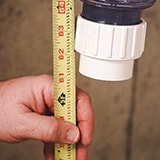 Measure the length of the PVC pipe you'll need to cut and mark it on the pipe. Remember to measure twice and cut once—you can always take more off, but you can't put length back on.
Measure the length of the PVC pipe you'll need to cut and mark it on the pipe. Remember to measure twice and cut once—you can always take more off, but you can't put length back on. 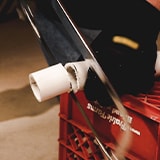 Using your hacksaw, begin sawing through the line and attempt to cut as straight a line as possible. Do not let the piping tip upward or downward while cutting, or else the final edge may not be straight. If the cut is crooked, the pipe may leak or not fit properly into the fitting.
Using your hacksaw, begin sawing through the line and attempt to cut as straight a line as possible. Do not let the piping tip upward or downward while cutting, or else the final edge may not be straight. If the cut is crooked, the pipe may leak or not fit properly into the fitting.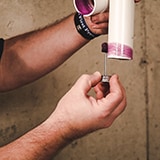 Prime the inside of the fitting and the outer edge of the piping using the standard PVC primer. More than likely, it will be purple and comes with a brush to apply the primer to your pipe and connectors. Just be aware that this primer can stain skin and clothing, so apply with caution.
Prime the inside of the fitting and the outer edge of the piping using the standard PVC primer. More than likely, it will be purple and comes with a brush to apply the primer to your pipe and connectors. Just be aware that this primer can stain skin and clothing, so apply with caution.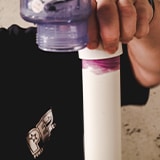 The trick to ensuring a solid bond between the PVC pipe and your fitting is to twist the pipe inside the fitting a quarter-turn and hold for about fifteen to twenty seconds in order to activate the chemical reaction that will bond the cement and primer together. If you don't twist after putting the two together, the bond may not hold and your pipe may leak.
The trick to ensuring a solid bond between the PVC pipe and your fitting is to twist the pipe inside the fitting a quarter-turn and hold for about fifteen to twenty seconds in order to activate the chemical reaction that will bond the cement and primer together. If you don't twist after putting the two together, the bond may not hold and your pipe may leak. 
